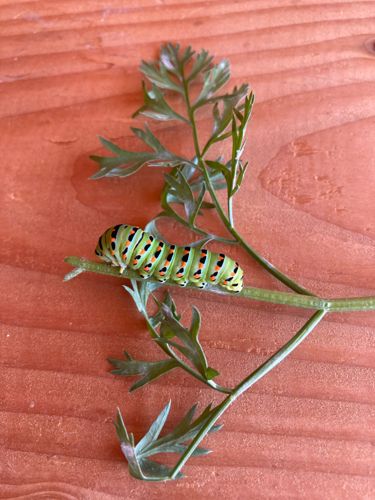Black Swallowtail Caterpillar
Scientific Name: Papilio polyxenes
Order & Family: Order: Lepidoptera, Family: Papilionidae
Size: Caterpillars grow up to 5-6 cm (2-2.5 inches) in length before pupating.

Natural Habitat
Black Swallowtail caterpillars are found in gardens, fields, meadows, and other open areas where their host plants grow. They are commonly seen in agricultural settings and home gardens.
Diet & Feeding
The primary diet of the Black Swallowtail caterpillar consists of the leaves of plants in the carrot family (Apiaceae). This includes dill, parsley, fennel, carrots, and celery. The caterpillar in the image appears to be on a plant from this family, likely parsley or dill.
Behavior Patterns
This caterpillar is the larval stage of a butterfly. It undergoes complete metamorphosis, meaning it will pupate and then emerge as an adult butterfly. Caterpillars typically spend their time feeding voraciously to grow, molting several times before pupating. They may exhibit defensive behaviors such as expelling a foul-smelling substance from an osmeterium (a fleshy, eversible organ behind the head) when disturbed. They are day-active feeders.
Risks & Benefits
Potential Risks: While generally not considered a pest, in large numbers, they can cause defoliation to garden plants like parsley, dill, or carrots. They pose no direct risk to humans. Potential Benefits: As adults, Black Swallowtail butterflies are important pollinators for a wide variety of flowering plants. The caterpillars themselves are part of the food web, serving as a food source for birds and other predators.
Identified on: 8/16/2025